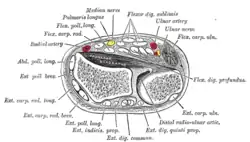Extensor retinaculum of the hand
The extensor retinaculum (dorsal carpal ligament, or posterior annular ligament) is a thickened portion of the antebrachial fascia that holds the tendons of the extensor muscles in place.[1] It is located on the back of the forearm, just proximal to the hand.[2] It is continuous with the palmar carpal ligament (which is located on the anterior side of the forearm).
| Extensor retinaculum of the hand | |
|---|---|
 | |
| Details | |
| Identifiers | |
| Latin | retinaculum musculorum extensorum manus |
| TA98 | A04.6.03.010 |
| TA2 | 2546 |
| FMA | 39987 |
| Anatomical terminology | |
Structure
The extensor retinaculum is a strong, fibrous band, extending obliquely downward and medialward across the back of the wrist.[2] It consists of part of the deep fascia of the back of the forearm, strengthened by the addition of some transverse fibers.
Relations
There are six separate synovial sheaths run beneath the extensor retinaculum: (1st) abductor pollicis longus and extensor pollicis brevis tendons, (2nd) extensor carpi radialis lungus and brevis tendons, (3rd) extensor pollicis longus tendon, (4th) extensor digitorium communis and extensor indicis proprius tendons, (5th) extensor digiti minimi tendon and (6th) extensor carpi ulnaris tendon.[3]
On the dorsal side of the hand, the palmar carpal ligament corresponds in location and structure to the extensor retinaculum, both being formations of the antebrachial fascia and therefore continuous. Consequently, the flexor retinaculum is commonly referred to as the transverse carpal ligament to avoid confusion.[4]
Histology
Structurally, the retinaculum consists of three layers. The deepest layer, the gliding layer, consists of hyaluronic acid-secreting cells. The thick middle layer consists of interspersed elastin fibers, collagen bundles, and fibroblasts. The most superficial layer is made up of loose connective tissue which contains vascular channels. Combined these three layers create a smooth gliding surface as well as mechanically strong tissue which prevents tendon bowstringing.[5] The extensor retinaculum of the foot has similar structure.
Clinical significance
Studies conducted on the retinaculum have exhibited it to have several possible surgical treatments uses. A graft of the extensor retinaculum was shown to be useful in treating boxer's knuckle when direct repair of the damaged capsule is not possible.[6] Because of their similarities in histological structure, studies also show the extensor retinaculum to be a reasonable biological replacement for reconstruction of a deficient annular pulley.[6]
Additional images
 Transverse section across distal ends of radius and ulna.
Transverse section across distal ends of radius and ulna. Extensor retinaculum of the hand.Deep dissection.
Extensor retinaculum of the hand.Deep dissection.
References
- PALMER, A. K.; SKAHEN, J. R.; WERNER, F. W.; GLISSON, R. R. (2016-11-17). "The Extensor Retinaculum of The Wrist: An Anatomical and Biomechanical Study". Journal of Hand Surgery. 10 (1): 11–16. doi:10.1016/S0266-7681(85)80006-1. PMID 3998587. S2CID 11507945.
- Drake, Richard L. (Richard Lee), 1950- (2005). Gray's anatomy for students. Vogl, Wayne., Mitchell, Adam W. M., Gray, Henry, 1825-1861. Philadelphia: Elsevier/Churchill Livingstone. ISBN 0-443-06612-4. OCLC 55139039.
{{cite book}}: CS1 maint: multiple names: authors list (link) - Sobotta anatomy textbook. Friedrich Paulsen, Tobias M. Böckers, J. Waschke, Stephan Winkler, Katja Dalkowski, Jörg Mair, Sonja Klebe, Elsevier ClinicalKey. Munich. 2019. ISBN 978-0-7020-6760-0. OCLC 1132300315.
{{cite book}}: CS1 maint: location missing publisher (link) CS1 maint: others (link) - Moore, Keith L.; Dalley, Arthur F.; Agur, Anne M. R. (2018). Clinically Oriented Anatomy (8th ed.). Wolters Kluwer. p. 159. ISBN 978-1-4963-4721-3.
- Klein, David M.; Katzman, Barry M.; Mesa, Joseph A.; Lipton, Jeffrey F.; Caligiuri, Daniel A. (1999-01-01). "Histology of the Extensor Retinaculum of the Wrist and the Ankle". The Journal of Hand Surgery. 24 (4): 799–802. doi:10.1053/jhsu.1999.0799. ISSN 0363-5023. PMID 10447172.
- Nagaoka, Masahiro; Satoh, Takako; Nagao, Soya; Matsuzaki, Hiromi (2006-07-01). "Extensor Retinaculum Graft for Chronic Boxer's Knuckle". The Journal of Hand Surgery. 31 (6): 947–951. doi:10.1016/j.jhsa.2006.02.027. ISSN 0363-5023. PMID 16843154.